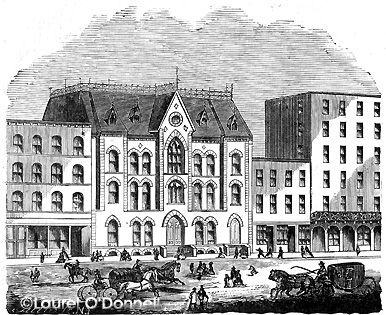|
|
Chapter V
Institutions of Manhattan Island and Westchester Co.
Howard Mission and Home For Little Wanderers,
page 2 of 2  Howard Mission (When Completed)
Our WORK is chiefly with the children. These are divided into three classes, consisting of 1st. Those placed under our care to be sent to homes and situations. 2d. Those whom we are not authorized to send to homes, but who need a temporary shelter until their friends can provide for them or surrender them to us. Note. —These two classes remain day and night in the Mission. 3d. Those who have homes or places in which to sleep. These enjoy the benefits of the wardrobe, dining and school rooms, but do not sleep in the Mission. Food, fuel, and clothing are given to the poor, after a careful inspection of their condition. Mothers leave their small children in the day nursery during the day, while they go out to work. The sick are visited, assisted, and comforted. Work is sought for the unemployed. We help the poor to help themselves. The children over whom we can get legal control are placed in carefully selected Christian families, chiefly in the country, either for adoption or as members of the families, where they are tenderly cared for in sickness and in health—sent to Sunday School and Church—receive a good Common School education—trained to some useful business, trade or profession, and thus fitted for the great duties of mature life. DAY AND SUNDAY Schools. —The attendance, neatness, order, cheerfulness enthusiasm, and rapid improvement in the Day and Sunday Schools are the best testimonials that our teachers can have of their fitness for their work. CONCLUSION. —Since the commencement of the Mission more than 10,000 children have been received into its Day and Sunday Schools, hundreds of whom have been placed in carefully selected Christian homes. Many of them have grown up to usefulness and comfort, and some to positions of influence and importance.We know that our work prevents crime; keeps hundreds of children out of the streets, keeps boys out of bar-rooms, gambling houses and prisons, and girls out of concert saloons, dance-houses, and other avenues that lead down to death; and that it makes hundreds of cellar and attic homes more cleanly, more healthy, more happy, and less wretched, wicked, and hopeless. We never turn a homeless child from our door. From past experience we are warranted in saying that one dollar a week will keep a well-filled plate on our table for any little wanderer, and secure to it all the benefits of the Mission. Ten dollars will pay the average cost of placing a child in a good home." Many apply at the Mission for a child. It is amusing hear their inquiries and the replies of the superintendent. "Have you a nice little girl to send away into a good family?" said one of two well-dressed ladies, who entered the office while we there in quest of information for this chapter. "No, we have not—yes, we have one," said the superintendent, "a dear little girl who is just recovering from measles, and who has been exposed to soarlet fever and will probably be sick with it by to-morrow. She needs some good, kind mother to love her, and nurse her, and train her up. I am afraid the angels will come for her soon, unless some of you mothers take her." They were not in search of such a child and turned toward the street. When a class of these children was taken West some years ago an old lady of wealth came to their lodgings and said, "If you have a crippled boy give him to me; my dear boy died with the spinal complaint." There was one little fellow in the group afflicted with this spinal difficulty, and she took him to her nice home, procured the best medical skill in that part of the State, and after years of good treatment he recovered, and is now a successful man. In September, 1861, the "Little Wanderer's Friend," the organ of the Mission, a 16mo. now issued quarterly, was established. It contains the music sung in the Mission, the history of the Institution, and other selections and thought gems. It has now a circulation of five thousand copies. The Institution is conducted at an annual expense of from $35,000 to $40,000, which is derived from voluntary contributions. |
|
157
:: Previous Page :: Next Page ::
:: Table of Contents :: :: New York State :: :: History Readings :: Books & articles appearing here are modified adaptations
from a private collection of vintage books & magazines. Reproduction of these pages is prohibited without written permission. © Laurel O’Donnell, 1996-2006.
|
|


